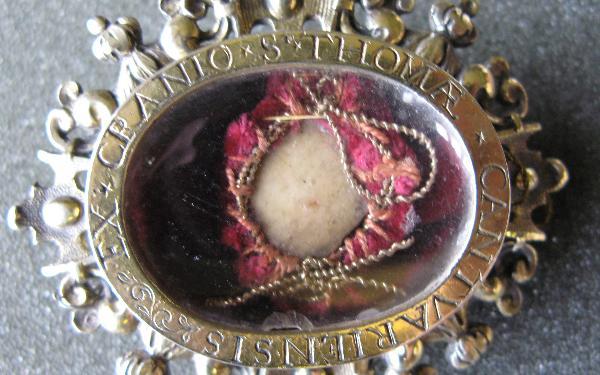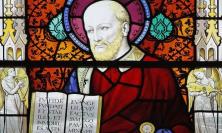A startling exhibition of relics at the British Museum until 9 October features important contributions from the British Province of the Society of Jesus and Stonyhurst College. Stonyhurst curator, Jan Graffius describes the fascinating history of the objects on loan to Treasures of Heaven: Saints, relics and devotion in medieval Europe, and urges visitors to appreciate the beauty and meaning of the exhibition.
The Treasures of Heaven exhibition currently running at the British Museum has tackled a very contentious issue – one which, to be honest, often generates an unease among Catholics. As often as they inspire reverence and piety, relics can shock, repulse and cause offence, or simply provoke uncomprehending incredulity. In Britain we do not, as a rule, encounter relics displayed in our churches in quite the open manner as in France, Spain, Italy or other countries with a strong Catholic presence. We are unused to coming face to face with human remains and the experience can be an uncomfortable one, especially in light of received wisdom from the Reformation onwards, castigating the sale of dubious relics as part of the corruption which saw the end of Catholicism as the national religion.
Relics and the Church
The exhibition traces the practice of relic retention back to the early Christian Church and even beyond, displaying for example a simple yet powerful Etruscan sarcophagus, shaped like a house with a winged man guarding the door. The exhibits demonstrate the progression from the pre-Christian practice of displaying body parts and keeping the dead close at hand, to the early Church’s collection of the bodies of their martyrs and sanctifying the places of their deaths. It was felt that the practice of touching, seeing, kissing the bodies of these martyrs helped to convey their holiness and their power, or dynamis,to heal the sick and affect miracles. Gregory of Nazianzos wrote in the late 4th century,
The bodies of the martyrs have the same power as their holy souls, whether one touches them or just venerates them. Just a few drops of their blood, the signs of their sufferings, can effect the same as their bodies.
Or, as St John Chrysostom taught,
The bodies of the saints are a stronger protection for our city than any adamantine or inexpugnable fortifications. Like so many high look-out towers they repulse the onslaughts….repelling every device of the devil.
Relics became part of the daily fabric of religious life in the Church and their prestige grew with their significance, prompting churchmen, politicians and rulers to indulge in underhand practices and less-than-holy political manoeuvring to get their hands on something valuable. Relics attracted pilgrims, whose spending power in local hostels and shops was highly prized, and whose vulnerability to the hopes of health cures and miracles made them exploitable financially by the unscrupulous. The scandals of the middle ages are well documented and are still quoted regularly whenever the subject comes up in discussion – the quip that there are enough pieces of the True Cross floating around to build an armada of ships is well known.
John Calvin’s powerfully-worded Treatise on Relics in 1543 scornfully laid bare some of the more egregiously fraudulent relics held in churches around Europe, but went further to attack the very concept of venerating even genuine relics:
It will thus be found that, to have relics is a useless and frivolous thing, which will most probably gradually lead towards idolatry, because they cannot be handled and looked upon without being honoured, and in doing this men will very soon render them the honour which is due to Jesus Christ. In short, the desire for relics is never without superstition, and what is worse, it is usually the parent of idolatry.
In the face of the growing unease at the abuses of the use of relics, the Council of Trent, in its 25th session, reaffirmed their importance to the Catholic Church in December 1558:
Also that the holy bodies of holy martyrs, and of others now living with Christ – which bodies were the living members of Christ, and the temple of the Holy Ghost, and which are by Him to be raised unto eternal life, and to be glorified – are to be venerated by the faithful; through which (bodies) many benefits are bestowed by God on men.
Jesuit contributions to the exhibition
Stonyhurst College and the British Province of the Society of Jesus have made three important loans to the exhibition. Undoubtedly the most memorable is the remarkable object known as the Holy Thorn of Mary, Queen of Scots, owned by the British Province and cared for at Stonyhurst. It has a venerable and extraordinary history, which is related here, unapologetically, at some length.
According to ancient tradition, the Crown of Thorns, along with the Cross and other relics of the Crucifixion were hidden in Jerusalem for three centuries until their location was revealed in a dream to St Helena. Many of these relics were kept in Jerusalem; others were transferred to Constantinople, where Helena’s son, Emperor Constantine displayed them, using bizarrely one of the nails from the Crucifixion as a bit for his horse, according to later commentators.
The Fourth Crusade’s sacking of Constantinople in 1204 dispersed one of the most important collections of relics held outside Rome. The Crusade’s leader, Count Baldwin, decided that there were richer pickings to be had by sacking the city, rather than the decidedly riskier prospect of seizing Jerusalem. Baldwin crowned himself emperor and seized as many of the assets of the imperial family as he could lay his hands on, including the Crown of Thorns. In 1238, distinctly short of money, he pawned it to a consortium of Venetian merchants and finally sold it for 10,000 livres in 1239 to Louis IX (1214-1270), King of France – the future St Louis. The king brought the Crown and other relics back to France and built the exquisite Sainte-Chapelle in Paris as a fitting setting in which to hold them, hoping to turn Paris into the New Jerusalem. There they remained for five hundred years until the French Revolution. In 1794 the mob broke into the chapel, looted it and dispersed or destroyed its relics. The Crown was lost and all that remains of it today – in Notre Dame Cathedral in Paris – is the mat of twisted reeds on which it once sat.
No fewer than one hundred and thirty authenticated thorns from the Crown still survive, thanks to the French royal family’s generous habit over the centuries of breaking off individual thorns to present as gifts to worthy recipients. In 1558, the young Mary, Queen of Scots, was given a double thorn from the Crown in honour of her marriage to the French dauphin, subsequently François II (1544–1560). She left France a widow in 1560, but kept the two thorns with her at Holyrood in Edinburgh until her stormy reign in Scotland ended in flight to England in 1568. There, she continued her intrigues, plotting to usurp the English throne from her Protestant cousin, Elizabeth I. To further this aim, Mary presented her ardent advocate, Thomas Percy (1528-1572), seventh Earl of Northumberland, with the double thorn. He wore it constantly in a gold crucifix until his execution for his part in the ill-fated 1569 rising of the northern earls.
On the eve of his death in 1572, Percy gave the thorns to his daughter, Elizabeth Woodruffe, or Woodroff, who subsequently became a staunch friend of the Jesuits in England. In 1594, she gave both thorns to the Jesuit, Father John Gerard (1564-1637), as a gift to the Society of Jesus. Her friend, Jane Wiseman, of Braddocks in Essex, arranged for the two thorns to be divided and each was encased in an elaborate, enamelled gold reliquary. Twined round the thorn are pearls that reputedly belonged to Mary, Queen of Scots, and on the base of each reliquary is an inscription crediting Elizabeth Woodroff and Jane Wiseman for their contribution to the new housing for the thorn. Both reliquaries remained in London until 1665, when, at the height of the Great Plague, special arrangements were made in case death should overtake the Jesuits guarding them and in case the thorns should fall thereafter into the wrong hands. The two thorns were sent over to Flanders – one to St Omer and the other to the nearby English Jesuit noviciate at Watten. The Watten thorn passed into the hands of the Bishop of Ghent in 1773, when the Jesuit order was suppressed: it can still be seen today in the Church of St Michael the Archangel in Ghent. The remaining thorn moved with the college from St Omer to Bruges in 1762. The college was seized by Austrian troops in 1773 when the Jesuits were suppressed: the Austrians looted the college and a group of pupils were so outraged at the treatment of their school that they broke open the chained cupboard in which the thorn was kept. Hugh Clifford, aged seventeen, took the thorn and set out home for England in the company of another pupil and of a Jesuit scholastic. The little group broke their journey at the English Charterhouse, home of the exiled English Carthusians, at Nieuwpoort on the Flemish coast, where they told the prior about the treasure they were carrying. He threatened the boys with excommunication for sacrilege, took possession of the thorn and promptly returned it to the Austrian authorities in Bruges. There it remained until 1781 when a former pupil of St Omer, Thomas Weld (1750-1810), was travelling in the Low Countries. In Bruges, he heard about the thorn and, remembering it from his schooldays, determined to recover it. He visited the Bruges notary in whose custody it lay, offered him five guineas for the reliquary, and took the thorn back to his estate in Lulworth, Dorset. The thorn was venerated in his private chapel for twenty-two years until 1803, when he generously presented it to the Jesuits at his old school, which had been relocated to Stonyhurst College in Lancashire. The beautiful Elizabethan reliquary of gold, enamel and rock crystal housing the Thorn has symbols of the Passion depicted around the sides. The modern case now housing it was made by Louis Osman in 1963.
Stonyhurst College has lent to the exhibition a late 15th century manuscript, Preces Variae, originally owned by a member of the French royal family for use during the Mass in the Sainte-Chapelle. It is open at an illuminated page showing the many relics of the Passion held in the Sacristy there, including a crystal and gold reliquary containing the Crown of Thorns.
A second exhibit (pictured with this article) lent by the British Province is a small fragment of the skull of Thomas of Canterbury, or Becket. It is housed in a silver gilt brooch reliquary intended to be inserted into the front of a Flemish baroque statue of the saint, made for the Jesuit seminary at Liege in the 17th century. The fragment of skull may well be that which was entrusted to Fr John Gerard SJ in the early 17th century, as described in his Autobiography. It is interesting because, in addition to its history and romantic association with recusants who did so much to preserve pre-Reformation relics, the piece of bone is clearly visible through the glass, rather than being hidden behind a wall of gold and silver gilt. During the Counter Reformation, such a setting of relics was encouraged so that they could be seen clearly, to avoid accusations of fraud.
Treasures of Heaven at the British Museum
The exhibition at the British Museum concludes with the Reformation and incorporates a range of relics from those of the Passion through the early Church to the middle ages. There are startling ‘speaking reliquaries’, formed in the shape of the body parts they contain, and exquisite examples of medieval craftsmanship such as the stunning Thorn reliquary owned by the British Museum, originally made for Jean, Duc de Berry in the 1390s.
The exhibition is clearly laid out, with sensitively-worded labels and a thought provoking audio guide. The catalogue is scholarly and beautifully illustrated – the only drawback being that those items which did not travel on the touring part of the exhibition, such as the ones from the Jesuits and Stonyhurst, are not listed. The exhibition ends with a photo montage of modern day ‘saints’, with voiceovers from contemporary commentators including teenagers musing on the significance of ancient witnesses to sanctity and martyrdom.
Modern relics
Despite living, as we are constantly told, in a secular age, we still have an interest nowadays in relics: items such as Marilyn Monroe’s white dress, Michael Jackson’s gloves or pieces of the Berlin Wall link us to the glamorous, famous and historic events and people of our age; they are traded in auction houses and on eBay, reaching huge sums. The need to hold physical reminders of someone admired, famous or dear to our hearts appears to be part of human nature, even though in the modern West we appear to venerate money and celebrity rather than sanctity.
And yet experience in other parts of the world indicates that respect for the witness of Christian martyrs still exists. I have been involved for some years in the preservation and display of the martyr vestments of Archbishop Oscar Romero, stained with the blood shed when he was shot while saying Mass in 1980. These vestments hold great significance for the poor of El Salvador, for whom Romero was their only voice. In the face of past government propaganda and official attempts to downplay his murder, these bloodstained and bullet-holed vestments speak the truth loudly and inconveniently. They are visited daily by pilgrims from El Salvador and from all over the world. These relics are part of the chain that links the present, still-persecuted Church with the earliest martyrs of the Roman Empire.
It is a revelation to visit this exhibition, therefore, and find beauty and meaning in the relics and reliquaries on display and in the inspiring and powerful stories of the people associated with their collection and preservation. The British Museum has treated the objects themselves with respect and has sought sensitively and honestly to describe their meaning to the Christian communities which preserved them. In so doing, they have prompted us to ask ourselves: what do these things mean for us today? There is much in this exhibition to admire and to provoke discussion. Do see it before it closes on 9 October.
Jan Graffius is the Curator of Stonyhurst College.
The exhibition, Treasures of Heaven: Saints, relics and devotion in medieval Europe, runs until 9 October at the British Museum in London.
![]() Treasures of Heaven: Saints, relics and devotion in medieval Europe at the British Museum
Treasures of Heaven: Saints, relics and devotion in medieval Europe at the British Museum![]() Stonyhurst College
Stonyhurst College






